Health Financial Management
VerifiedAdded on 2023/01/19
|12
|2834
|97
AI Summary
This article discusses the costs of medicine consumption in Australia, the medicines consumed under the Pharmaceutical Benefits Scheme (PBS), challenges facing PBS, and recommendations for improving health financial management. It explores the funding of medicines in a cost-effective way, the role of PBS in providing access to prescription medicines, and the need for transparency and resource allocation in managing PBS. The article concludes with recommendations for enhancing communication and promoting sustainability in the healthcare industry.
Contribute Materials
Your contribution can guide someone’s learning journey. Share your
documents today.
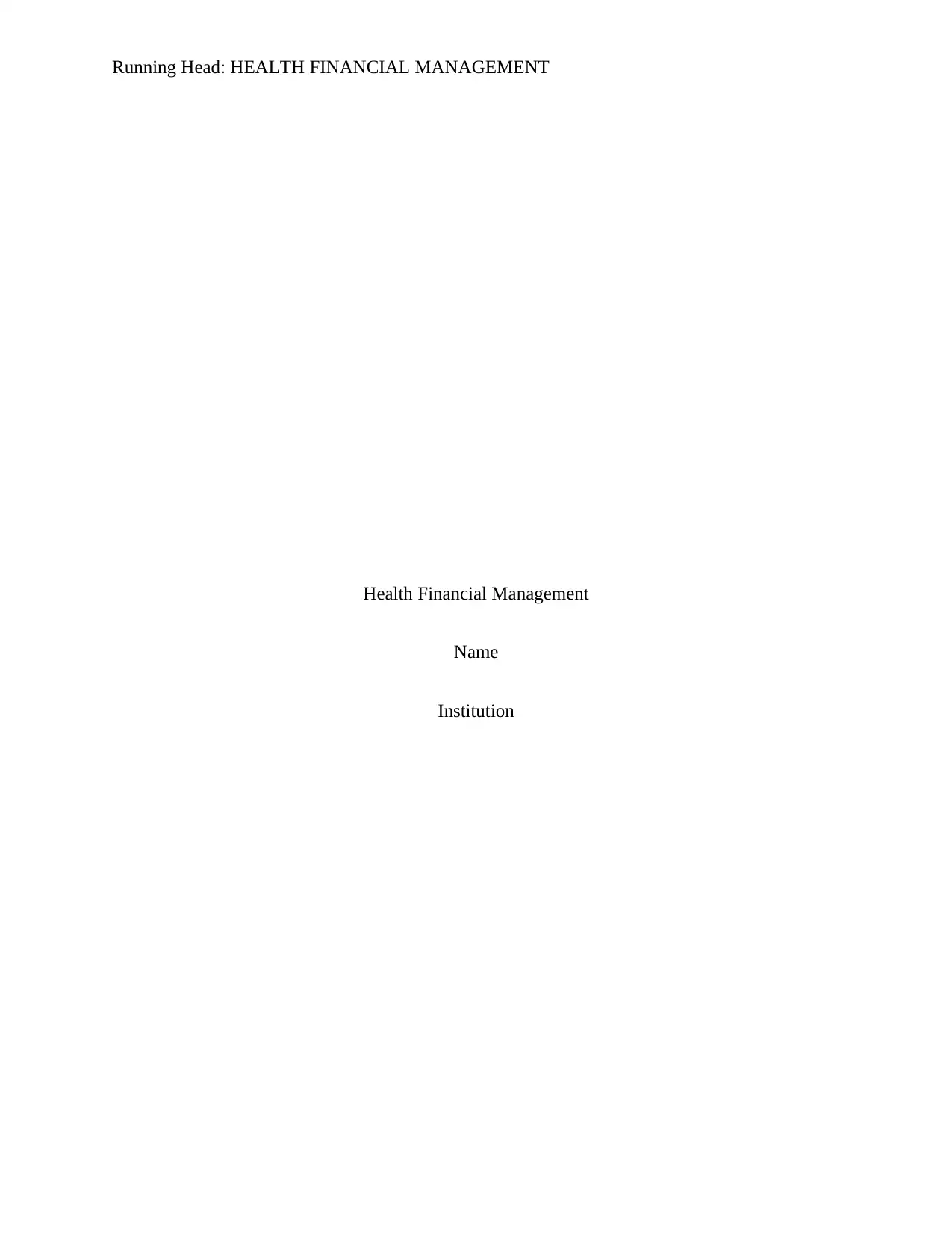
Running Head: HEALTH FINANCIAL MANAGEMENT
Health Financial Management
Name
Institution
Health Financial Management
Name
Institution
Secure Best Marks with AI Grader
Need help grading? Try our AI Grader for instant feedback on your assignments.

HEALTH FINANCIAL MANAGEMENT 2
Health Financial Management
Table of Contents
Introduction......................................................................................................................................3
Costs of Medicine Consumption.....................................................................................................3
Medicines Consumed in Australia...................................................................................................5
Challenges Facing PBS....................................................................................................................7
Recommendations............................................................................................................................8
Conclusions......................................................................................................................................9
References......................................................................................................................................11
Health Financial Management
Table of Contents
Introduction......................................................................................................................................3
Costs of Medicine Consumption.....................................................................................................3
Medicines Consumed in Australia...................................................................................................5
Challenges Facing PBS....................................................................................................................7
Recommendations............................................................................................................................8
Conclusions......................................................................................................................................9
References......................................................................................................................................11

HEALTH FINANCIAL MANAGEMENT 3
Introduction
The funding of medicines in a cost-effective way is an endutring problem for health
policies in several nations across the world. In Australia in which the government runs as a
healthcare single payer system, equilibrium should be attained between access to new and new
medicines, as well as managing the cost of Pharmaceutical Benefits Scheme (PBS). Lately, the
Australian govern,ent made the decision to fund a ground-breaking class of novel medicines to
people with hepatitis C of over $ 1 billion based on forward budget projections; however,
offering consiuderable gains for patients by adequately healing the disease (AIHW, 2017a). The
decision was arrived at partly by balancing the gains of the therapies versus their cost via
healthcare economic evalutions. Australian citizens are covered for healthcare services through a
national scheme (Medicare) that covers different programmes. PBS is among these programs that
helps with the costs prescription medicines dispenses in the community in addition to private
healthcare facilities and some pharmaceuticals dispensed to public hospital outpatients plus in
public hospitals emergency departments. Patients in Australia contribute to the costs of
medicines under the PBS via copayments (Department of Health, 2017).
The paper will examine the costs of medicines in Australia and drugs under the PBS
programs and challenges facing PBS and finally offer recommendations.
Costs of Medicine Consumption
PBS is the 10th biggest Commonwealth Government program, currently costing over $9
billion annually. This is a vital aspect of the healthcare systems because it offers access to drugs
Introduction
The funding of medicines in a cost-effective way is an endutring problem for health
policies in several nations across the world. In Australia in which the government runs as a
healthcare single payer system, equilibrium should be attained between access to new and new
medicines, as well as managing the cost of Pharmaceutical Benefits Scheme (PBS). Lately, the
Australian govern,ent made the decision to fund a ground-breaking class of novel medicines to
people with hepatitis C of over $ 1 billion based on forward budget projections; however,
offering consiuderable gains for patients by adequately healing the disease (AIHW, 2017a). The
decision was arrived at partly by balancing the gains of the therapies versus their cost via
healthcare economic evalutions. Australian citizens are covered for healthcare services through a
national scheme (Medicare) that covers different programmes. PBS is among these programs that
helps with the costs prescription medicines dispenses in the community in addition to private
healthcare facilities and some pharmaceuticals dispensed to public hospital outpatients plus in
public hospitals emergency departments. Patients in Australia contribute to the costs of
medicines under the PBS via copayments (Department of Health, 2017).
The paper will examine the costs of medicines in Australia and drugs under the PBS
programs and challenges facing PBS and finally offer recommendations.
Costs of Medicine Consumption
PBS is the 10th biggest Commonwealth Government program, currently costing over $9
billion annually. This is a vital aspect of the healthcare systems because it offers access to drugs
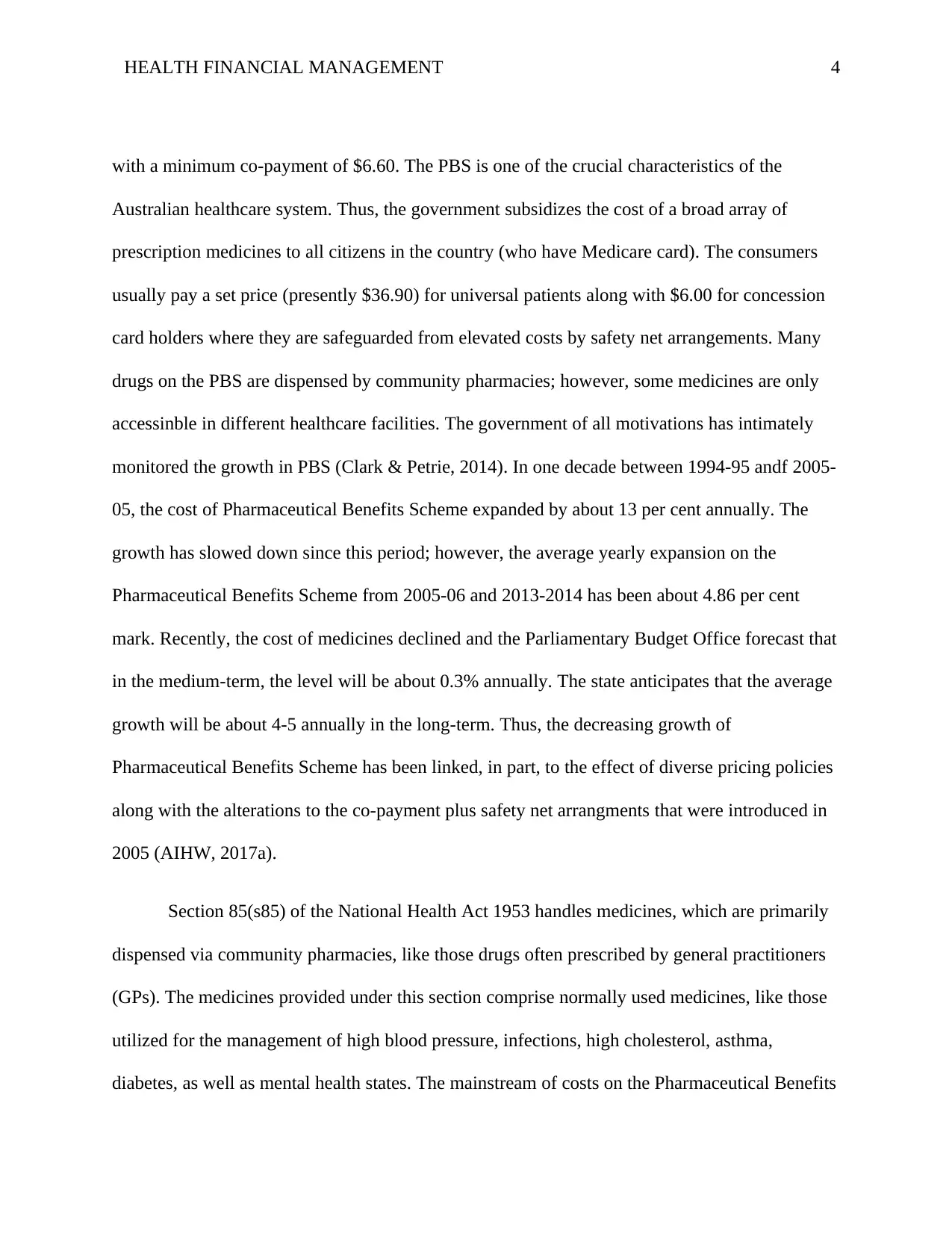
HEALTH FINANCIAL MANAGEMENT 4
with a minimum co-payment of $6.60. The PBS is one of the crucial characteristics of the
Australian healthcare system. Thus, the government subsidizes the cost of a broad array of
prescription medicines to all citizens in the country (who have Medicare card). The consumers
usually pay a set price (presently $36.90) for universal patients along with $6.00 for concession
card holders where they are safeguarded from elevated costs by safety net arrangements. Many
drugs on the PBS are dispensed by community pharmacies; however, some medicines are only
accessinble in different healthcare facilities. The government of all motivations has intimately
monitored the growth in PBS (Clark & Petrie, 2014). In one decade between 1994-95 andf 2005-
05, the cost of Pharmaceutical Benefits Scheme expanded by about 13 per cent annually. The
growth has slowed down since this period; however, the average yearly expansion on the
Pharmaceutical Benefits Scheme from 2005-06 and 2013-2014 has been about 4.86 per cent
mark. Recently, the cost of medicines declined and the Parliamentary Budget Office forecast that
in the medium-term, the level will be about 0.3% annually. The state anticipates that the average
growth will be about 4-5 annually in the long-term. Thus, the decreasing growth of
Pharmaceutical Benefits Scheme has been linked, in part, to the effect of diverse pricing policies
along with the alterations to the co-payment plus safety net arrangments that were introduced in
2005 (AIHW, 2017a).
Section 85(s85) of the National Health Act 1953 handles medicines, which are primarily
dispensed via community pharmacies, like those drugs often prescribed by general practitioners
(GPs). The medicines provided under this section comprise normally used medicines, like those
utilized for the management of high blood pressure, infections, high cholesterol, asthma,
diabetes, as well as mental health states. The mainstream of costs on the Pharmaceutical Benefits
with a minimum co-payment of $6.60. The PBS is one of the crucial characteristics of the
Australian healthcare system. Thus, the government subsidizes the cost of a broad array of
prescription medicines to all citizens in the country (who have Medicare card). The consumers
usually pay a set price (presently $36.90) for universal patients along with $6.00 for concession
card holders where they are safeguarded from elevated costs by safety net arrangements. Many
drugs on the PBS are dispensed by community pharmacies; however, some medicines are only
accessinble in different healthcare facilities. The government of all motivations has intimately
monitored the growth in PBS (Clark & Petrie, 2014). In one decade between 1994-95 andf 2005-
05, the cost of Pharmaceutical Benefits Scheme expanded by about 13 per cent annually. The
growth has slowed down since this period; however, the average yearly expansion on the
Pharmaceutical Benefits Scheme from 2005-06 and 2013-2014 has been about 4.86 per cent
mark. Recently, the cost of medicines declined and the Parliamentary Budget Office forecast that
in the medium-term, the level will be about 0.3% annually. The state anticipates that the average
growth will be about 4-5 annually in the long-term. Thus, the decreasing growth of
Pharmaceutical Benefits Scheme has been linked, in part, to the effect of diverse pricing policies
along with the alterations to the co-payment plus safety net arrangments that were introduced in
2005 (AIHW, 2017a).
Section 85(s85) of the National Health Act 1953 handles medicines, which are primarily
dispensed via community pharmacies, like those drugs often prescribed by general practitioners
(GPs). The medicines provided under this section comprise normally used medicines, like those
utilized for the management of high blood pressure, infections, high cholesterol, asthma,
diabetes, as well as mental health states. The mainstream of costs on the Pharmaceutical Benefits
Secure Best Marks with AI Grader
Need help grading? Try our AI Grader for instant feedback on your assignments.
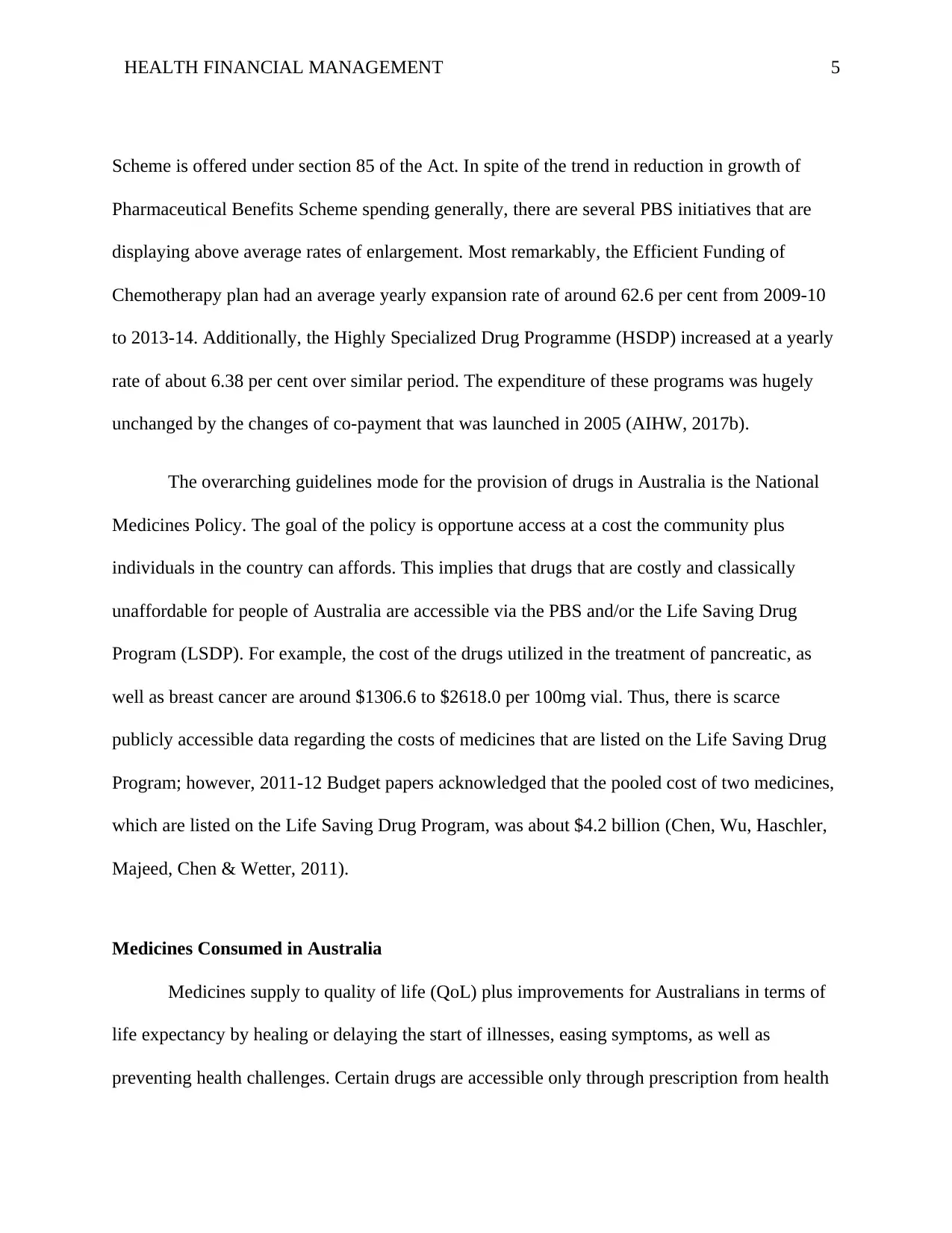
HEALTH FINANCIAL MANAGEMENT 5
Scheme is offered under section 85 of the Act. In spite of the trend in reduction in growth of
Pharmaceutical Benefits Scheme spending generally, there are several PBS initiatives that are
displaying above average rates of enlargement. Most remarkably, the Efficient Funding of
Chemotherapy plan had an average yearly expansion rate of around 62.6 per cent from 2009-10
to 2013-14. Additionally, the Highly Specialized Drug Programme (HSDP) increased at a yearly
rate of about 6.38 per cent over similar period. The expenditure of these programs was hugely
unchanged by the changes of co-payment that was launched in 2005 (AIHW, 2017b).
The overarching guidelines mode for the provision of drugs in Australia is the National
Medicines Policy. The goal of the policy is opportune access at a cost the community plus
individuals in the country can affords. This implies that drugs that are costly and classically
unaffordable for people of Australia are accessible via the PBS and/or the Life Saving Drug
Program (LSDP). For example, the cost of the drugs utilized in the treatment of pancreatic, as
well as breast cancer are around $1306.6 to $2618.0 per 100mg vial. Thus, there is scarce
publicly accessible data regarding the costs of medicines that are listed on the Life Saving Drug
Program; however, 2011-12 Budget papers acknowledged that the pooled cost of two medicines,
which are listed on the Life Saving Drug Program, was about $4.2 billion (Chen, Wu, Haschler,
Majeed, Chen & Wetter, 2011).
Medicines Consumed in Australia
Medicines supply to quality of life (QoL) plus improvements for Australians in terms of
life expectancy by healing or delaying the start of illnesses, easing symptoms, as well as
preventing health challenges. Certain drugs are accessible only through prescription from health
Scheme is offered under section 85 of the Act. In spite of the trend in reduction in growth of
Pharmaceutical Benefits Scheme spending generally, there are several PBS initiatives that are
displaying above average rates of enlargement. Most remarkably, the Efficient Funding of
Chemotherapy plan had an average yearly expansion rate of around 62.6 per cent from 2009-10
to 2013-14. Additionally, the Highly Specialized Drug Programme (HSDP) increased at a yearly
rate of about 6.38 per cent over similar period. The expenditure of these programs was hugely
unchanged by the changes of co-payment that was launched in 2005 (AIHW, 2017b).
The overarching guidelines mode for the provision of drugs in Australia is the National
Medicines Policy. The goal of the policy is opportune access at a cost the community plus
individuals in the country can affords. This implies that drugs that are costly and classically
unaffordable for people of Australia are accessible via the PBS and/or the Life Saving Drug
Program (LSDP). For example, the cost of the drugs utilized in the treatment of pancreatic, as
well as breast cancer are around $1306.6 to $2618.0 per 100mg vial. Thus, there is scarce
publicly accessible data regarding the costs of medicines that are listed on the Life Saving Drug
Program; however, 2011-12 Budget papers acknowledged that the pooled cost of two medicines,
which are listed on the Life Saving Drug Program, was about $4.2 billion (Chen, Wu, Haschler,
Majeed, Chen & Wetter, 2011).
Medicines Consumed in Australia
Medicines supply to quality of life (QoL) plus improvements for Australians in terms of
life expectancy by healing or delaying the start of illnesses, easing symptoms, as well as
preventing health challenges. Certain drugs are accessible only through prescription from health
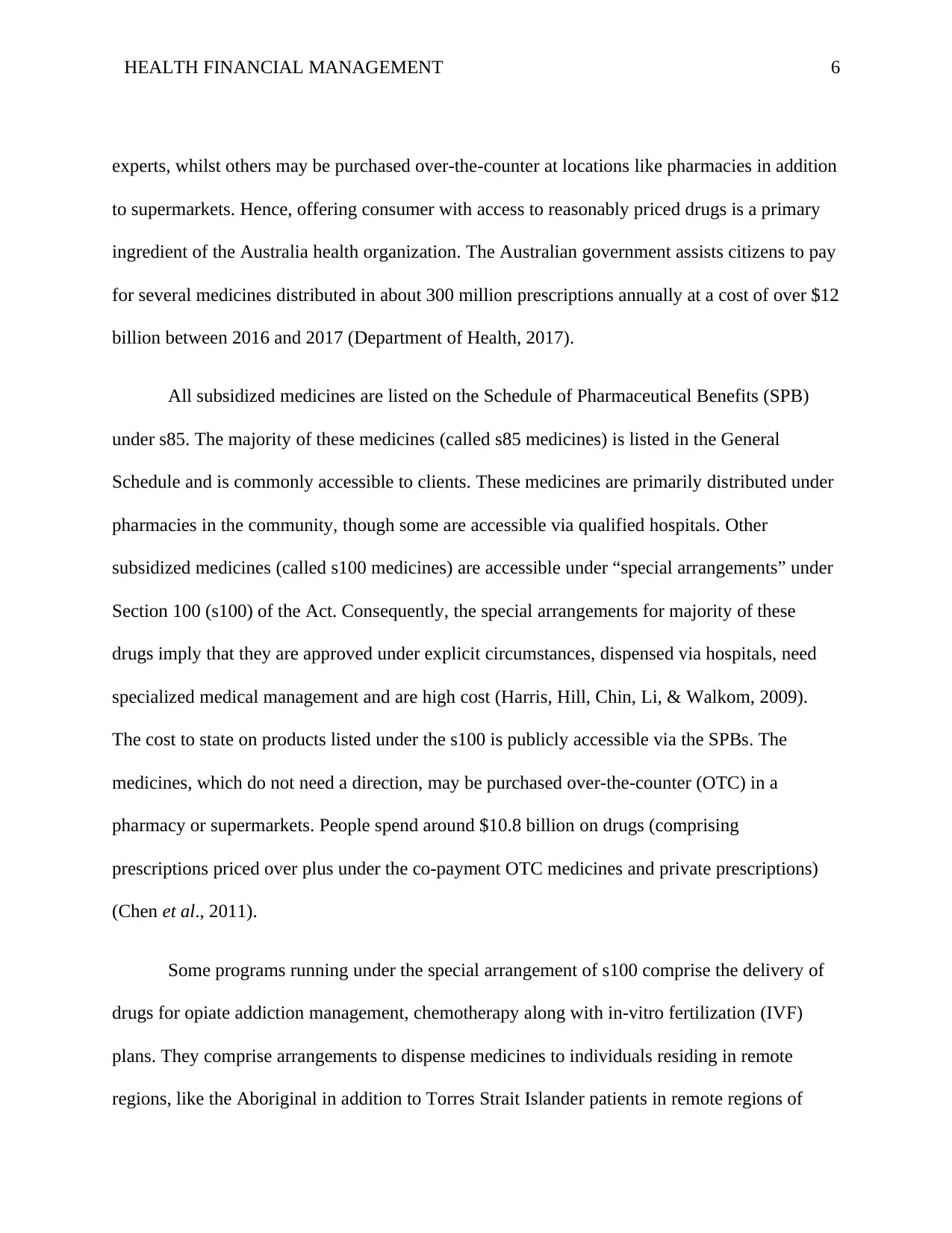
HEALTH FINANCIAL MANAGEMENT 6
experts, whilst others may be purchased over-the-counter at locations like pharmacies in addition
to supermarkets. Hence, offering consumer with access to reasonably priced drugs is a primary
ingredient of the Australia health organization. The Australian government assists citizens to pay
for several medicines distributed in about 300 million prescriptions annually at a cost of over $12
billion between 2016 and 2017 (Department of Health, 2017).
All subsidized medicines are listed on the Schedule of Pharmaceutical Benefits (SPB)
under s85. The majority of these medicines (called s85 medicines) is listed in the General
Schedule and is commonly accessible to clients. These medicines are primarily distributed under
pharmacies in the community, though some are accessible via qualified hospitals. Other
subsidized medicines (called s100 medicines) are accessible under “special arrangements” under
Section 100 (s100) of the Act. Consequently, the special arrangements for majority of these
drugs imply that they are approved under explicit circumstances, dispensed via hospitals, need
specialized medical management and are high cost (Harris, Hill, Chin, Li, & Walkom, 2009).
The cost to state on products listed under the s100 is publicly accessible via the SPBs. The
medicines, which do not need a direction, may be purchased over-the-counter (OTC) in a
pharmacy or supermarkets. People spend around $10.8 billion on drugs (comprising
prescriptions priced over plus under the co-payment OTC medicines and private prescriptions)
(Chen et al., 2011).
Some programs running under the special arrangement of s100 comprise the delivery of
drugs for opiate addiction management, chemotherapy along with in-vitro fertilization (IVF)
plans. They comprise arrangements to dispense medicines to individuals residing in remote
regions, like the Aboriginal in addition to Torres Strait Islander patients in remote regions of
experts, whilst others may be purchased over-the-counter at locations like pharmacies in addition
to supermarkets. Hence, offering consumer with access to reasonably priced drugs is a primary
ingredient of the Australia health organization. The Australian government assists citizens to pay
for several medicines distributed in about 300 million prescriptions annually at a cost of over $12
billion between 2016 and 2017 (Department of Health, 2017).
All subsidized medicines are listed on the Schedule of Pharmaceutical Benefits (SPB)
under s85. The majority of these medicines (called s85 medicines) is listed in the General
Schedule and is commonly accessible to clients. These medicines are primarily distributed under
pharmacies in the community, though some are accessible via qualified hospitals. Other
subsidized medicines (called s100 medicines) are accessible under “special arrangements” under
Section 100 (s100) of the Act. Consequently, the special arrangements for majority of these
drugs imply that they are approved under explicit circumstances, dispensed via hospitals, need
specialized medical management and are high cost (Harris, Hill, Chin, Li, & Walkom, 2009).
The cost to state on products listed under the s100 is publicly accessible via the SPBs. The
medicines, which do not need a direction, may be purchased over-the-counter (OTC) in a
pharmacy or supermarkets. People spend around $10.8 billion on drugs (comprising
prescriptions priced over plus under the co-payment OTC medicines and private prescriptions)
(Chen et al., 2011).
Some programs running under the special arrangement of s100 comprise the delivery of
drugs for opiate addiction management, chemotherapy along with in-vitro fertilization (IVF)
plans. They comprise arrangements to dispense medicines to individuals residing in remote
regions, like the Aboriginal in addition to Torres Strait Islander patients in remote regions of
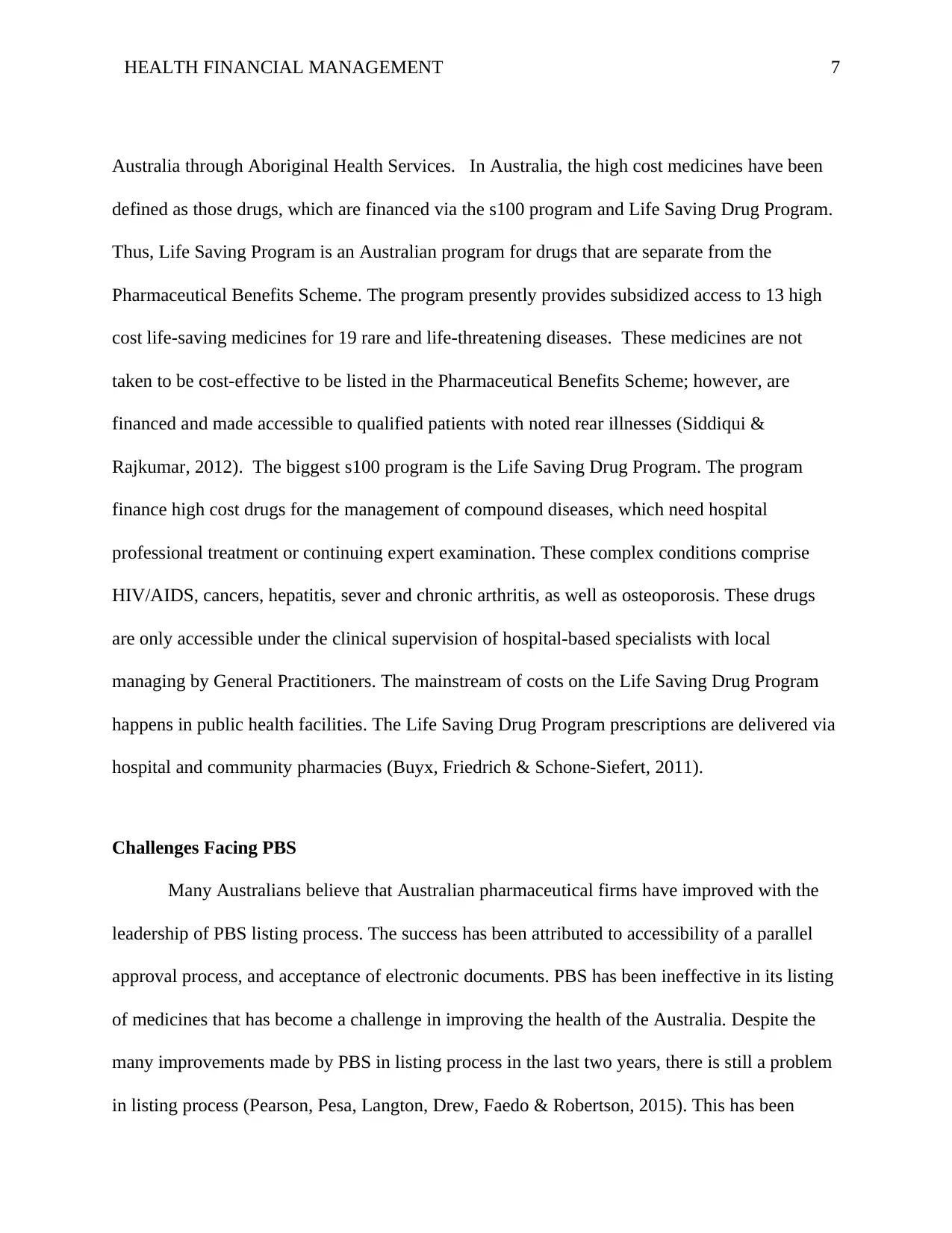
HEALTH FINANCIAL MANAGEMENT 7
Australia through Aboriginal Health Services. In Australia, the high cost medicines have been
defined as those drugs, which are financed via the s100 program and Life Saving Drug Program.
Thus, Life Saving Program is an Australian program for drugs that are separate from the
Pharmaceutical Benefits Scheme. The program presently provides subsidized access to 13 high
cost life-saving medicines for 19 rare and life-threatening diseases. These medicines are not
taken to be cost-effective to be listed in the Pharmaceutical Benefits Scheme; however, are
financed and made accessible to qualified patients with noted rear illnesses (Siddiqui &
Rajkumar, 2012). The biggest s100 program is the Life Saving Drug Program. The program
finance high cost drugs for the management of compound diseases, which need hospital
professional treatment or continuing expert examination. These complex conditions comprise
HIV/AIDS, cancers, hepatitis, sever and chronic arthritis, as well as osteoporosis. These drugs
are only accessible under the clinical supervision of hospital-based specialists with local
managing by General Practitioners. The mainstream of costs on the Life Saving Drug Program
happens in public health facilities. The Life Saving Drug Program prescriptions are delivered via
hospital and community pharmacies (Buyx, Friedrich & Schone-Siefert, 2011).
Challenges Facing PBS
Many Australians believe that Australian pharmaceutical firms have improved with the
leadership of PBS listing process. The success has been attributed to accessibility of a parallel
approval process, and acceptance of electronic documents. PBS has been ineffective in its listing
of medicines that has become a challenge in improving the health of the Australia. Despite the
many improvements made by PBS in listing process in the last two years, there is still a problem
in listing process (Pearson, Pesa, Langton, Drew, Faedo & Robertson, 2015). This has been
Australia through Aboriginal Health Services. In Australia, the high cost medicines have been
defined as those drugs, which are financed via the s100 program and Life Saving Drug Program.
Thus, Life Saving Program is an Australian program for drugs that are separate from the
Pharmaceutical Benefits Scheme. The program presently provides subsidized access to 13 high
cost life-saving medicines for 19 rare and life-threatening diseases. These medicines are not
taken to be cost-effective to be listed in the Pharmaceutical Benefits Scheme; however, are
financed and made accessible to qualified patients with noted rear illnesses (Siddiqui &
Rajkumar, 2012). The biggest s100 program is the Life Saving Drug Program. The program
finance high cost drugs for the management of compound diseases, which need hospital
professional treatment or continuing expert examination. These complex conditions comprise
HIV/AIDS, cancers, hepatitis, sever and chronic arthritis, as well as osteoporosis. These drugs
are only accessible under the clinical supervision of hospital-based specialists with local
managing by General Practitioners. The mainstream of costs on the Life Saving Drug Program
happens in public health facilities. The Life Saving Drug Program prescriptions are delivered via
hospital and community pharmacies (Buyx, Friedrich & Schone-Siefert, 2011).
Challenges Facing PBS
Many Australians believe that Australian pharmaceutical firms have improved with the
leadership of PBS listing process. The success has been attributed to accessibility of a parallel
approval process, and acceptance of electronic documents. PBS has been ineffective in its listing
of medicines that has become a challenge in improving the health of the Australia. Despite the
many improvements made by PBS in listing process in the last two years, there is still a problem
in listing process (Pearson, Pesa, Langton, Drew, Faedo & Robertson, 2015). This has been
Paraphrase This Document
Need a fresh take? Get an instant paraphrase of this document with our AI Paraphraser
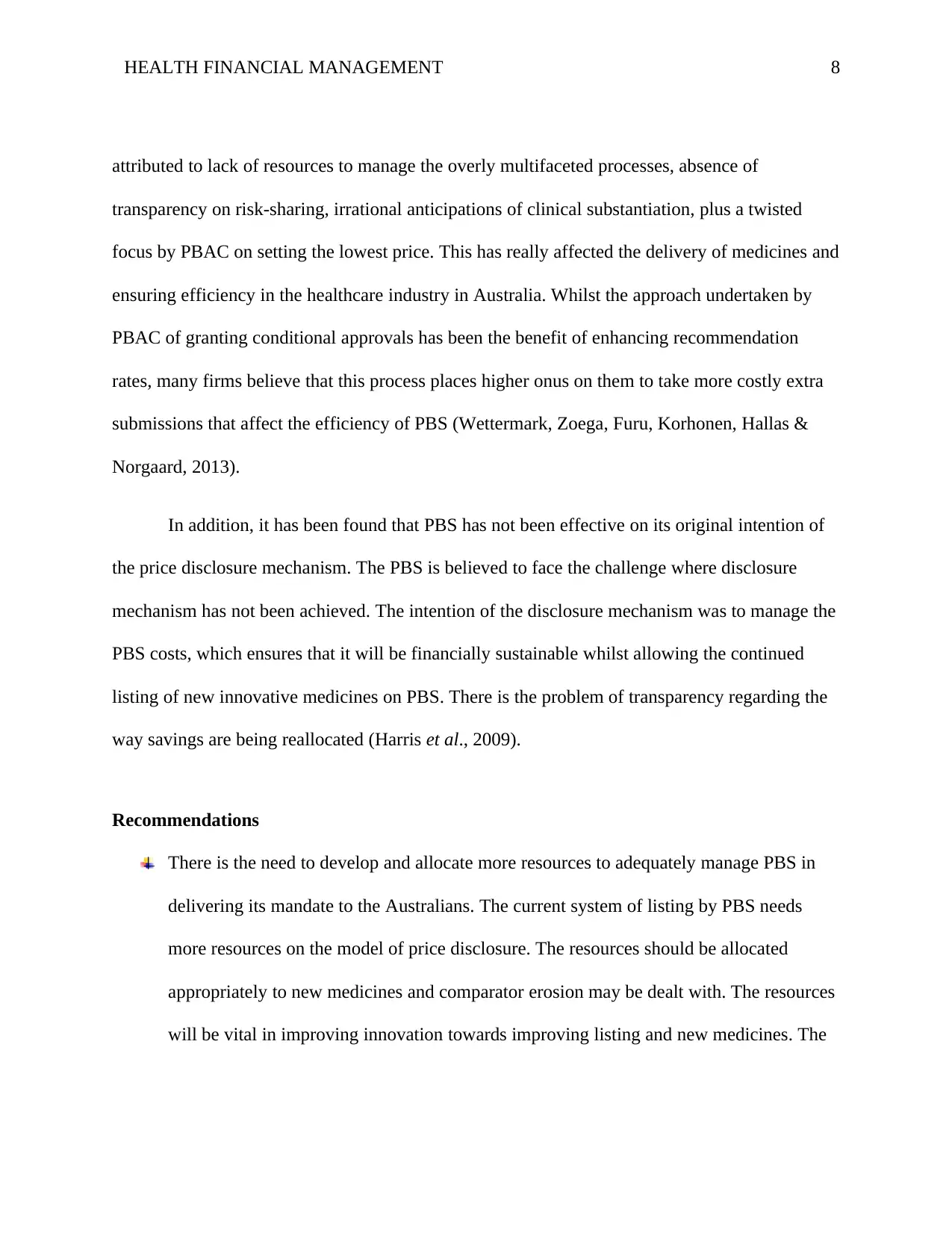
HEALTH FINANCIAL MANAGEMENT 8
attributed to lack of resources to manage the overly multifaceted processes, absence of
transparency on risk-sharing, irrational anticipations of clinical substantiation, plus a twisted
focus by PBAC on setting the lowest price. This has really affected the delivery of medicines and
ensuring efficiency in the healthcare industry in Australia. Whilst the approach undertaken by
PBAC of granting conditional approvals has been the benefit of enhancing recommendation
rates, many firms believe that this process places higher onus on them to take more costly extra
submissions that affect the efficiency of PBS (Wettermark, Zoega, Furu, Korhonen, Hallas &
Norgaard, 2013).
In addition, it has been found that PBS has not been effective on its original intention of
the price disclosure mechanism. The PBS is believed to face the challenge where disclosure
mechanism has not been achieved. The intention of the disclosure mechanism was to manage the
PBS costs, which ensures that it will be financially sustainable whilst allowing the continued
listing of new innovative medicines on PBS. There is the problem of transparency regarding the
way savings are being reallocated (Harris et al., 2009).
Recommendations
There is the need to develop and allocate more resources to adequately manage PBS in
delivering its mandate to the Australians. The current system of listing by PBS needs
more resources on the model of price disclosure. The resources should be allocated
appropriately to new medicines and comparator erosion may be dealt with. The resources
will be vital in improving innovation towards improving listing and new medicines. The
attributed to lack of resources to manage the overly multifaceted processes, absence of
transparency on risk-sharing, irrational anticipations of clinical substantiation, plus a twisted
focus by PBAC on setting the lowest price. This has really affected the delivery of medicines and
ensuring efficiency in the healthcare industry in Australia. Whilst the approach undertaken by
PBAC of granting conditional approvals has been the benefit of enhancing recommendation
rates, many firms believe that this process places higher onus on them to take more costly extra
submissions that affect the efficiency of PBS (Wettermark, Zoega, Furu, Korhonen, Hallas &
Norgaard, 2013).
In addition, it has been found that PBS has not been effective on its original intention of
the price disclosure mechanism. The PBS is believed to face the challenge where disclosure
mechanism has not been achieved. The intention of the disclosure mechanism was to manage the
PBS costs, which ensures that it will be financially sustainable whilst allowing the continued
listing of new innovative medicines on PBS. There is the problem of transparency regarding the
way savings are being reallocated (Harris et al., 2009).
Recommendations
There is the need to develop and allocate more resources to adequately manage PBS in
delivering its mandate to the Australians. The current system of listing by PBS needs
more resources on the model of price disclosure. The resources should be allocated
appropriately to new medicines and comparator erosion may be dealt with. The resources
will be vital in improving innovation towards improving listing and new medicines. The
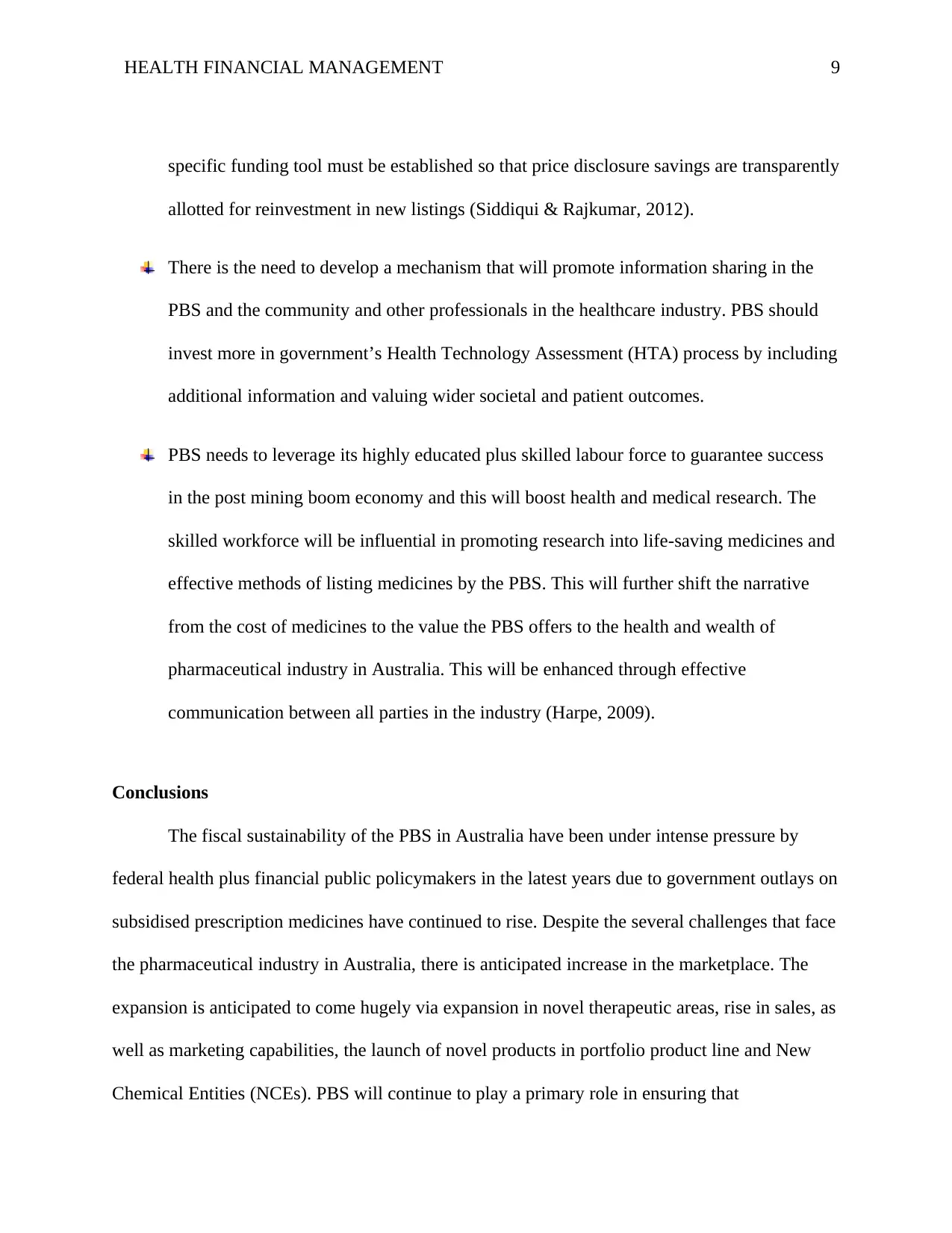
HEALTH FINANCIAL MANAGEMENT 9
specific funding tool must be established so that price disclosure savings are transparently
allotted for reinvestment in new listings (Siddiqui & Rajkumar, 2012).
There is the need to develop a mechanism that will promote information sharing in the
PBS and the community and other professionals in the healthcare industry. PBS should
invest more in government’s Health Technology Assessment (HTA) process by including
additional information and valuing wider societal and patient outcomes.
PBS needs to leverage its highly educated plus skilled labour force to guarantee success
in the post mining boom economy and this will boost health and medical research. The
skilled workforce will be influential in promoting research into life-saving medicines and
effective methods of listing medicines by the PBS. This will further shift the narrative
from the cost of medicines to the value the PBS offers to the health and wealth of
pharmaceutical industry in Australia. This will be enhanced through effective
communication between all parties in the industry (Harpe, 2009).
Conclusions
The fiscal sustainability of the PBS in Australia have been under intense pressure by
federal health plus financial public policymakers in the latest years due to government outlays on
subsidised prescription medicines have continued to rise. Despite the several challenges that face
the pharmaceutical industry in Australia, there is anticipated increase in the marketplace. The
expansion is anticipated to come hugely via expansion in novel therapeutic areas, rise in sales, as
well as marketing capabilities, the launch of novel products in portfolio product line and New
Chemical Entities (NCEs). PBS will continue to play a primary role in ensuring that
specific funding tool must be established so that price disclosure savings are transparently
allotted for reinvestment in new listings (Siddiqui & Rajkumar, 2012).
There is the need to develop a mechanism that will promote information sharing in the
PBS and the community and other professionals in the healthcare industry. PBS should
invest more in government’s Health Technology Assessment (HTA) process by including
additional information and valuing wider societal and patient outcomes.
PBS needs to leverage its highly educated plus skilled labour force to guarantee success
in the post mining boom economy and this will boost health and medical research. The
skilled workforce will be influential in promoting research into life-saving medicines and
effective methods of listing medicines by the PBS. This will further shift the narrative
from the cost of medicines to the value the PBS offers to the health and wealth of
pharmaceutical industry in Australia. This will be enhanced through effective
communication between all parties in the industry (Harpe, 2009).
Conclusions
The fiscal sustainability of the PBS in Australia have been under intense pressure by
federal health plus financial public policymakers in the latest years due to government outlays on
subsidised prescription medicines have continued to rise. Despite the several challenges that face
the pharmaceutical industry in Australia, there is anticipated increase in the marketplace. The
expansion is anticipated to come hugely via expansion in novel therapeutic areas, rise in sales, as
well as marketing capabilities, the launch of novel products in portfolio product line and New
Chemical Entities (NCEs). PBS will continue to play a primary role in ensuring that
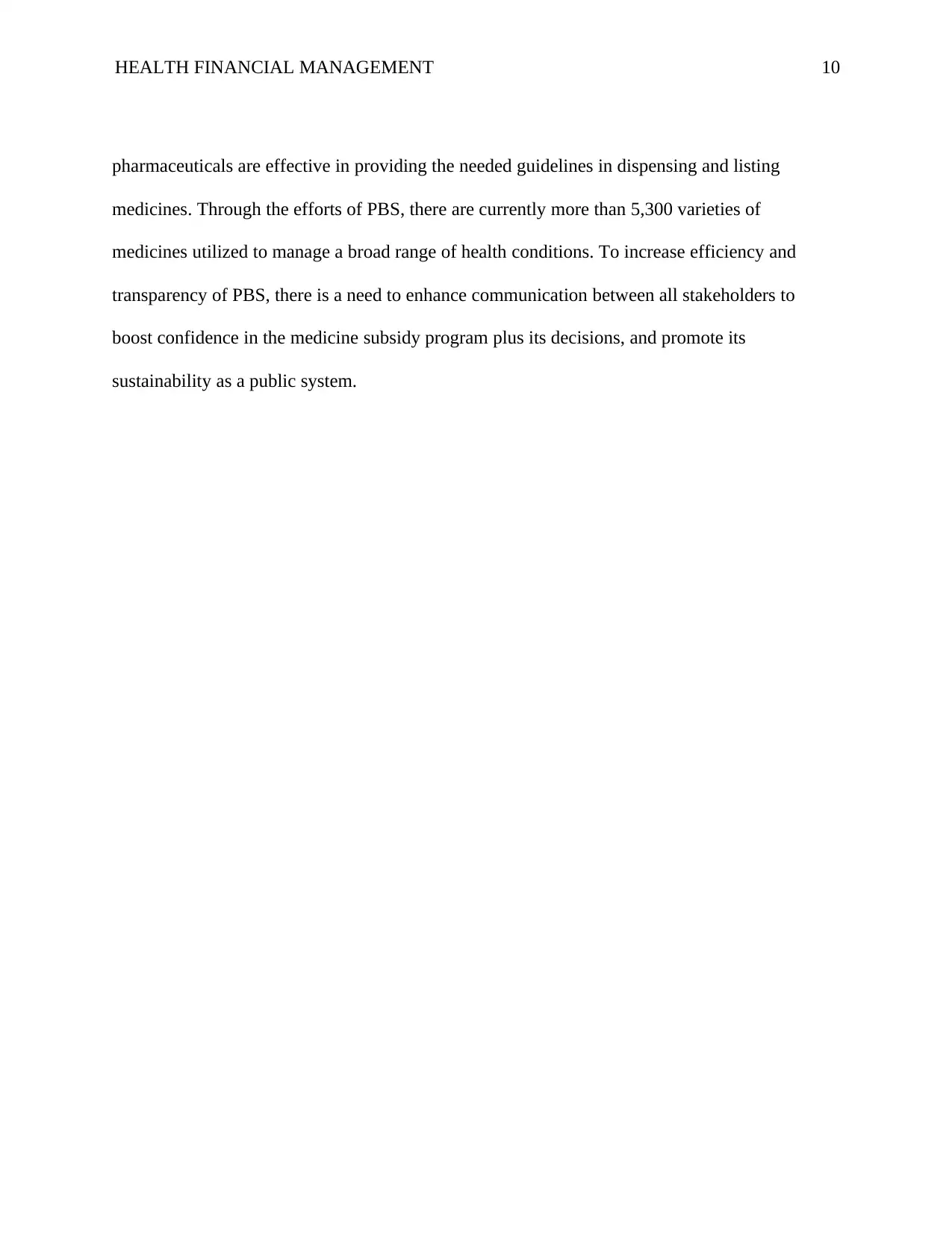
HEALTH FINANCIAL MANAGEMENT 10
pharmaceuticals are effective in providing the needed guidelines in dispensing and listing
medicines. Through the efforts of PBS, there are currently more than 5,300 varieties of
medicines utilized to manage a broad range of health conditions. To increase efficiency and
transparency of PBS, there is a need to enhance communication between all stakeholders to
boost confidence in the medicine subsidy program plus its decisions, and promote its
sustainability as a public system.
pharmaceuticals are effective in providing the needed guidelines in dispensing and listing
medicines. Through the efforts of PBS, there are currently more than 5,300 varieties of
medicines utilized to manage a broad range of health conditions. To increase efficiency and
transparency of PBS, there is a need to enhance communication between all stakeholders to
boost confidence in the medicine subsidy program plus its decisions, and promote its
sustainability as a public system.
Secure Best Marks with AI Grader
Need help grading? Try our AI Grader for instant feedback on your assignments.
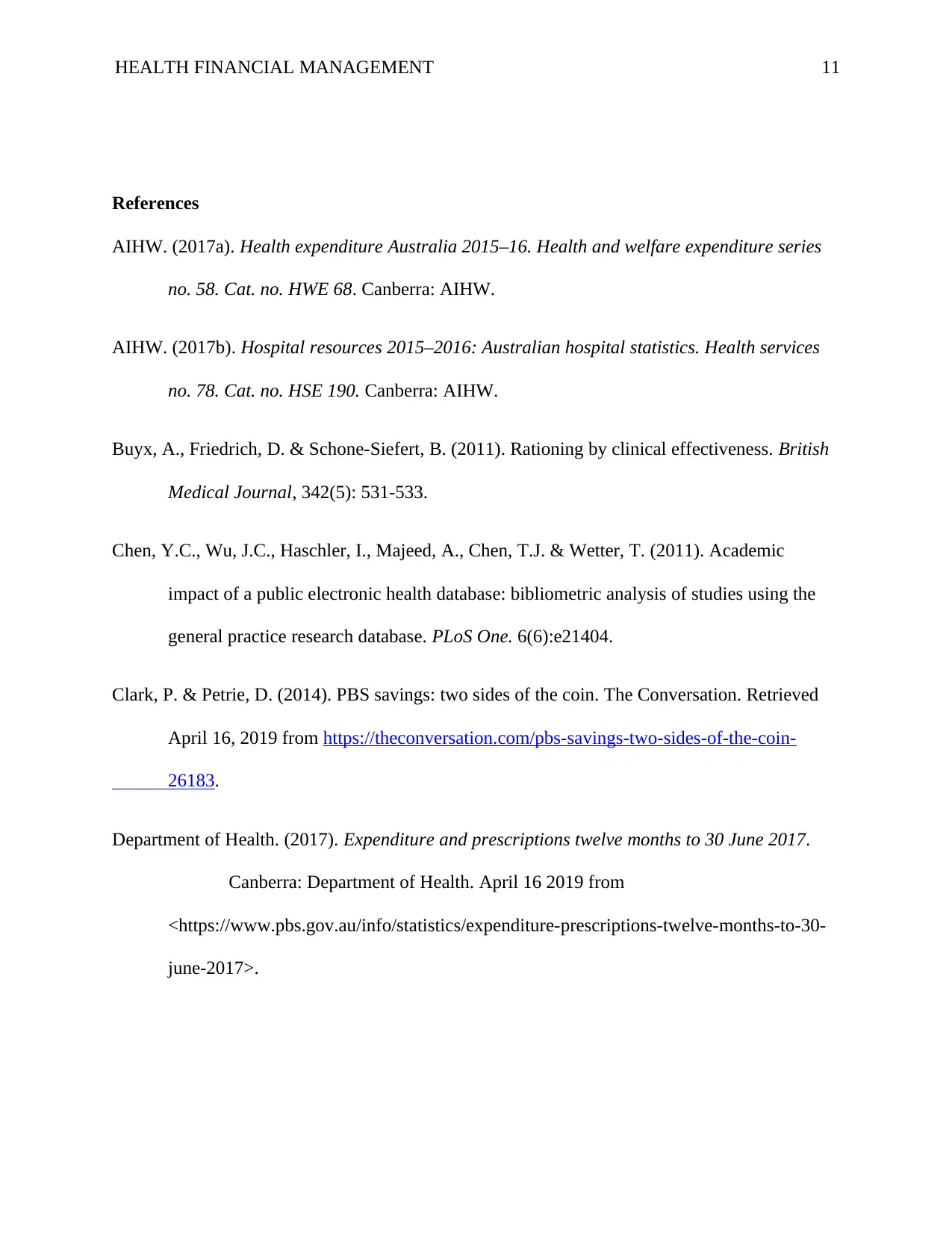
HEALTH FINANCIAL MANAGEMENT 11
References
AIHW. (2017a). Health expenditure Australia 2015–16. Health and welfare expenditure series
no. 58. Cat. no. HWE 68. Canberra: AIHW.
AIHW. (2017b). Hospital resources 2015–2016: Australian hospital statistics. Health services
no. 78. Cat. no. HSE 190. Canberra: AIHW.
Buyx, A., Friedrich, D. & Schone-Siefert, B. (2011). Rationing by clinical effectiveness. British
Medical Journal, 342(5): 531-533.
Chen, Y.C., Wu, J.C., Haschler, I., Majeed, A., Chen, T.J. & Wetter, T. (2011). Academic
impact of a public electronic health database: bibliometric analysis of studies using the
general practice research database. PLoS One. 6(6):e21404.
Clark, P. & Petrie, D. (2014). PBS savings: two sides of the coin. The Conversation. Retrieved
April 16, 2019 from https://theconversation.com/pbs-savings-two-sides-of-the-coin-
26183.
Department of Health. (2017). Expenditure and prescriptions twelve months to 30 June 2017.
Canberra: Department of Health. April 16 2019 from
<https://www.pbs.gov.au/info/statistics/expenditure-prescriptions-twelve-months-to-30-
june-2017>.
References
AIHW. (2017a). Health expenditure Australia 2015–16. Health and welfare expenditure series
no. 58. Cat. no. HWE 68. Canberra: AIHW.
AIHW. (2017b). Hospital resources 2015–2016: Australian hospital statistics. Health services
no. 78. Cat. no. HSE 190. Canberra: AIHW.
Buyx, A., Friedrich, D. & Schone-Siefert, B. (2011). Rationing by clinical effectiveness. British
Medical Journal, 342(5): 531-533.
Chen, Y.C., Wu, J.C., Haschler, I., Majeed, A., Chen, T.J. & Wetter, T. (2011). Academic
impact of a public electronic health database: bibliometric analysis of studies using the
general practice research database. PLoS One. 6(6):e21404.
Clark, P. & Petrie, D. (2014). PBS savings: two sides of the coin. The Conversation. Retrieved
April 16, 2019 from https://theconversation.com/pbs-savings-two-sides-of-the-coin-
26183.
Department of Health. (2017). Expenditure and prescriptions twelve months to 30 June 2017.
Canberra: Department of Health. April 16 2019 from
<https://www.pbs.gov.au/info/statistics/expenditure-prescriptions-twelve-months-to-30-
june-2017>.
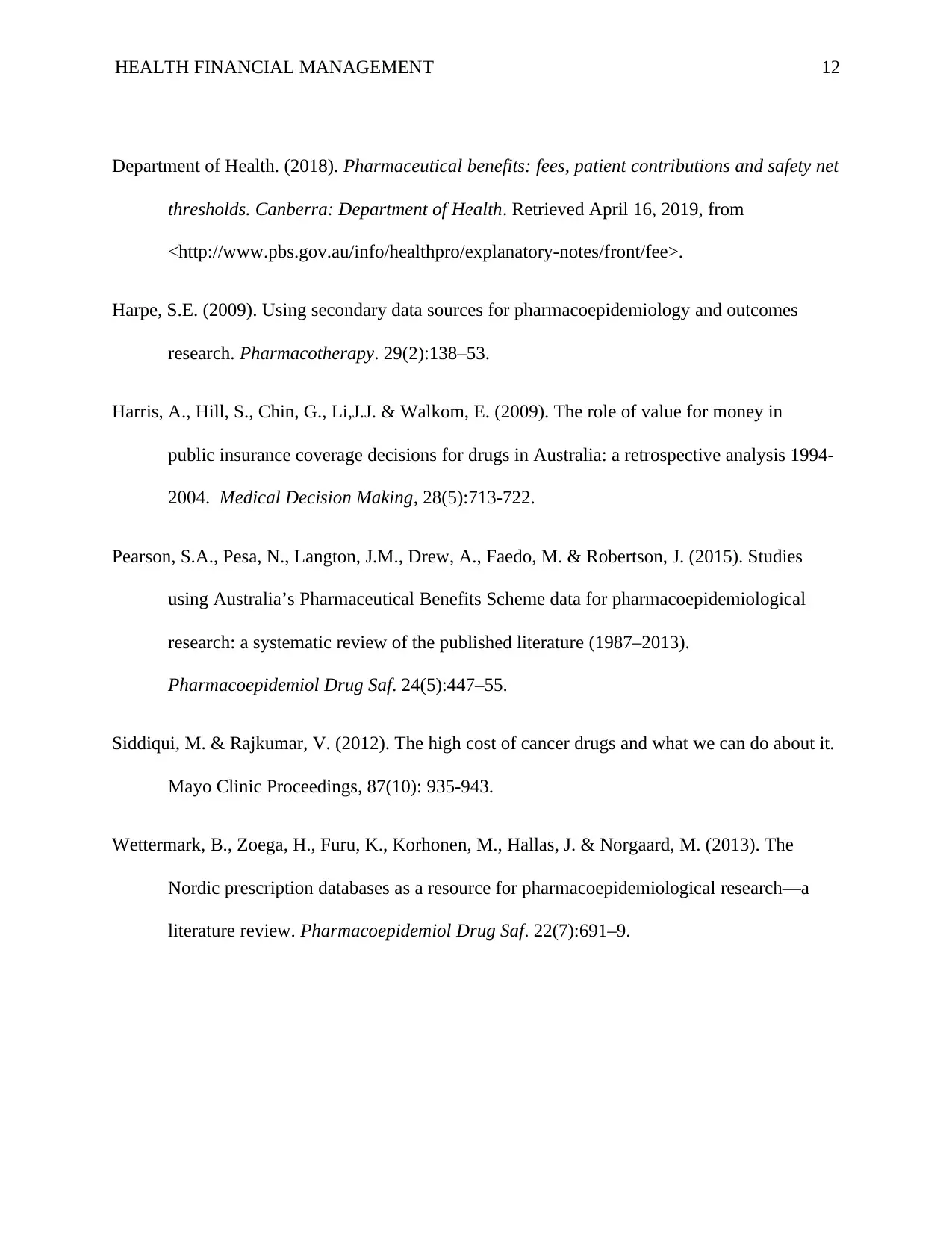
HEALTH FINANCIAL MANAGEMENT 12
Department of Health. (2018). Pharmaceutical benefits: fees, patient contributions and safety net
thresholds. Canberra: Department of Health. Retrieved April 16, 2019, from
<http://www.pbs.gov.au/info/healthpro/explanatory-notes/front/fee>.
Harpe, S.E. (2009). Using secondary data sources for pharmacoepidemiology and outcomes
research. Pharmacotherapy. 29(2):138–53.
Harris, A., Hill, S., Chin, G., Li,J.J. & Walkom, E. (2009). The role of value for money in
public insurance coverage decisions for drugs in Australia: a retrospective analysis 1994-
2004. Medical Decision Making, 28(5):713-722.
Pearson, S.A., Pesa, N., Langton, J.M., Drew, A., Faedo, M. & Robertson, J. (2015). Studies
using Australia’s Pharmaceutical Benefits Scheme data for pharmacoepidemiological
research: a systematic review of the published literature (1987–2013).
Pharmacoepidemiol Drug Saf. 24(5):447–55.
Siddiqui, M. & Rajkumar, V. (2012). The high cost of cancer drugs and what we can do about it.
Mayo Clinic Proceedings, 87(10): 935-943.
Wettermark, B., Zoega, H., Furu, K., Korhonen, M., Hallas, J. & Norgaard, M. (2013). The
Nordic prescription databases as a resource for pharmacoepidemiological research—a
literature review. Pharmacoepidemiol Drug Saf. 22(7):691–9.
Department of Health. (2018). Pharmaceutical benefits: fees, patient contributions and safety net
thresholds. Canberra: Department of Health. Retrieved April 16, 2019, from
<http://www.pbs.gov.au/info/healthpro/explanatory-notes/front/fee>.
Harpe, S.E. (2009). Using secondary data sources for pharmacoepidemiology and outcomes
research. Pharmacotherapy. 29(2):138–53.
Harris, A., Hill, S., Chin, G., Li,J.J. & Walkom, E. (2009). The role of value for money in
public insurance coverage decisions for drugs in Australia: a retrospective analysis 1994-
2004. Medical Decision Making, 28(5):713-722.
Pearson, S.A., Pesa, N., Langton, J.M., Drew, A., Faedo, M. & Robertson, J. (2015). Studies
using Australia’s Pharmaceutical Benefits Scheme data for pharmacoepidemiological
research: a systematic review of the published literature (1987–2013).
Pharmacoepidemiol Drug Saf. 24(5):447–55.
Siddiqui, M. & Rajkumar, V. (2012). The high cost of cancer drugs and what we can do about it.
Mayo Clinic Proceedings, 87(10): 935-943.
Wettermark, B., Zoega, H., Furu, K., Korhonen, M., Hallas, J. & Norgaard, M. (2013). The
Nordic prescription databases as a resource for pharmacoepidemiological research—a
literature review. Pharmacoepidemiol Drug Saf. 22(7):691–9.
1 out of 12
Related Documents
Your All-in-One AI-Powered Toolkit for Academic Success.
+13062052269
info@desklib.com
Available 24*7 on WhatsApp / Email
![[object Object]](/_next/static/media/star-bottom.7253800d.svg)
Unlock your academic potential
© 2024 | Zucol Services PVT LTD | All rights reserved.



